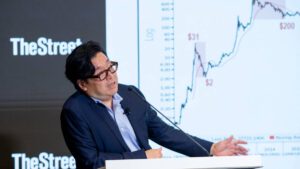Automakers have had an interesting 2025 so far, thanks to tariffs.
Take Ford, for example.
The Blue Oval expects the 25% tariffs on auto imports and parts to cost the company $3 billion this year.
Related: Car buyers beware, the market appears to be shifting gears
That’s the downside, but Ford has used incentives and ridden consumer fear of tariffs to become the top-selling brand in the U.S. during the first half of the year. Ford said total sales in the second quarter rose at a rate 7x that of the overall auto industry.
The 1.11 million units it sold in the first two quarters (a 6.6% year-over-year increase) were largely due to the employee pricing and 0-0-0 incentive programs.
“Automakers are providing healthy incentives to keep sales flowing. Prices are trending higher, but just as we are seeing in the broader retail markets, there’s sufficient demand and generous incentives out there, and that’s driving the market,” said Cox Automotive Executive Analyst Erin Keating.
More automotive:
- Ford Motor Co. has a much bigger issue than tariffs at its door
- US car buyers feel tariff pain as one automaker raises prices
- Latest Ford announcement adds to an expensive problem
Other carmakers have followed suit.
Industry-wide, car makers increased their incentive spending last month to 7.3% of new vehicle average transaction prices (ATP) from 7% in June, according to Cox Automotive.
Automakers spent an average of $3,553 per vehicle to move their inventory in July, reaching the high point for incentive spending this year.
The data suggests that wealthy buyers are the ones flocking to dealerships to buy ahead of tariffs impacting prices, and that they are also getting the best deals.
Image source: Shutterstock
Car affordability rebounds higher in July
For the second consecutive month, new vehicle affordability improved in July after taking a dip in May following the tariff announcement.
“In July, new-vehicle affordability improved to the best level since March, when tariffs were first announced,” said Cox Automotive Chief Economist Jonathan Smoke. “Higher incentives, higher incomes and lower prices combined for improving affordability conditions.”
Related: US car buyers should expect great summer deals, but there’s a catch
The number of median weeks of income needed to purchase the average new vehicle fell to 36.8 weeks from 37 weeks in June.
Last year, it took 38.6 weeks of median income to purchase a new vehicle. A year ago, prices were 1.5% lower, but interest rates were higher.
The average auto loan rate was steady month to month at 9.63% and 108 basis points (1.08 percentage points) lower year over year. Meanwhile, the average vehicle price decreased 0.1% in July and income growth remained strong at 3.4% year over year, according to Cox Automotive.
Consumers with good credit are getting better car loan interest rates
Federal interest rates don’t directly affect the deal you can get on a new car, but a new Cox Automotive study suggests that consumers with higher credit scores could get better deals.
“It is highly likely that, with sales slowing, consumers will benefit from attractive financing offers for the rest of the summer, but the catch is that those offers are typically only available to well-qualified buyers,” said Smoke.
Cox’s data shows that only about 7% of consumers financing new vehicle purchases are locking in a 0% annual percentage rate.
Meanwhile, the average new auto loan rate is above 9%. Even consumers with “very good” credit scores, above 760, were getting 5.4% rates in July. But that rate is still the lowest it has been since September 2022.
Related: 1 in 5 new car shoppers are committing a big financial blunder




